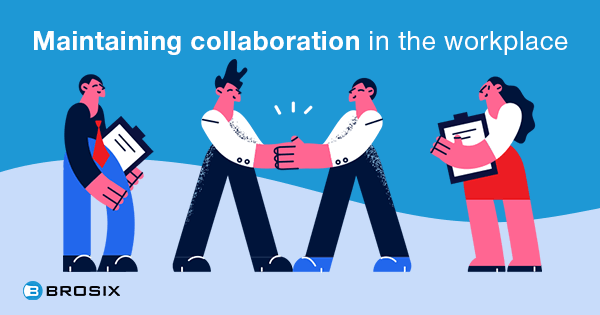Creating and fostering workplace collaboration is paramount for the company’s continued growth and building a productive and enjoyable environment for your team members.
However, while essential, high-level collaboration is hard to achieve given today’s hybrid nature of work. The way people work together has thoroughly changed in the last two decades. Companies become internationalized and grow in size, teams get bigger, and we increasingly rely on technology to cooperate with other people in our organization.
The COVID-19 pandemic has sent waves through every conceivable industry, forcing once close-knit team members to work on projects remotely without the ability to collaborate in the same way they used to.
As such, it’s more important than ever to dedicate time and resources to rebuilding and strengthening the collaborative spirit. According to International Data Corporation research, companies with intelligent and collaborative work environments will see 30% less staff turnover, 30% higher productivity, and 30% more revenue than their peers.
In this article, we’ll go over what workplace collaboration is, why it’s important, how to build the appropriate company culture to promote it, and how collaboration apps help you achieve it.
What Is Workspace Collaboration and Why Is It Important?
Workspace collaboration refers to employees and team members working together to achieve a common goal, solve problems, share skills, and pitch new ideas. At first glance, you might think that this is nothing more than a New Age corporatist concept with no actual meaning behind it. You would be wrong, as collaboration involves particular practices and approaches that any growth-oriented company should seek to employ.
Well-functioning workspace collaboration leads to innovation, the development of new solutions, and the sharing of knowledge and expertise among everyone on the team. You could have a crack team of experts, but if they’re not working together and are acting as solitary employees, you’ll be wasting money on productivity apps and revenue.
On the other hand, genuinely collaborating team members know that they can rely on each other to reach project goals, share ideas, and offer different perspectives while fostering deeper and more meaningful relationships.
However, it’s essential to keep in mind that building a collaborative culture is done on multiple levels. At the team level, you can improve workplace collaboration through the use of the right collaboration tools, the creation of proper strategies by managers and executives, and the reorganization of the workspace itself.
5 Benefits of Collaboration in the Workplace
Before we get to the best practices for promoting successful collaboration in your company, let’s go through the benefits of team collaboration. This will show you why it’s wise to invest money and time to encourage teamwork and collaboration and highlight which segments of your everyday work stand to benefit from this.
Encourages problem-solving among team members
When teams work together and pool their knowledge and expertise, they build a more robust apparatus for tackling issues and solving problems. This pool of soft skills and other perspectives is much stronger and more capable than the sum of its parts. When each employee works independently, with no proper communication and a clear goal in mind, they’ll encounter roadblocks with much greater frequency.
However, if the team has a problem-solving attitude and can overcome obstacles without wasting time or requiring outside intervention, this means they collaborate effectively.
Breeds innovation
Companies live and die by how innovative they are. While knowing and mastering industry-proven practices is a great start, you’ll want each team member to push boundaries, gain new skills, and look for new ideas and approaches. Engaged and collaborative teams will be more motivated and inspired to look for new solutions and ways to improve your business.
Cohesive teams
Teams that collaborate are bound to become more cohesive and connected. The results are two-pronged. First, teams will brainstorm ideas and work together more efficiently, learning how to cooperate better to meet the demands of any given project.
Secondly, employees will develop a more robust and durable form of internal communication to build lasting relationships. All of this results in higher employee happiness and retention rates, which are the backbone of any truly ambitious organization.
Knowledgeable employees
As we’ve mentioned before when you encourage collaboration at work, this will lead to teams and individual team members sharing skills among themselves. Not only does this help them solve the problems at hand, but this also represents a learning process for all the people involved. Hence, you’ll end up with a group of much more knowledgeable and capable workers than you initially started with.
Additionally, when you create a collaborative workplace, employees will be motivated to improve independently, and willing to brush up on their skills to help the company grow.
Workplace collaboration lets everyone see the bigger picture
One of the most commonly faced issues in the corporate world is the inability to bring together each employee in a unified vision of the company’s goals and targets. Without collaborating at work, members are often hyper-focused on their own projects and tasks, without seeing how and why it all comes together.
However, prolonged and effective collaboration in the workplace and the cooperation that results from it let team members see the bigger picture. They’ll be able to see how each employee and sector of the organization is connected, which will aid them in understanding their job better.
How to Achieve Effective Team Collaboration in the Workplace
Now that we’ve explained why effective collaboration is important, let’s see how to achieve it. Before you set out on this endeavor, remember that this is not something you can achieve overnight.
Planting the seeds of collaboration in the workplace takes time and needs to be performed on multiple levels. Additionally, this is not a process that ever truly ends, as you should constantly be on the lookout for ways to encourage cooperation to create a truly successful collaborative environment.
Here are the ways to achieve successful collaboration and teamwork between employees and reap the benefits of a truly unified organization.
Build trust between everyone in the workplace
One of the first and essential areas you should focus on is building a trusting atmosphere in the company. Naturally, this is often the most challenging part, and failure to do so can leave employees distrustful of one another and unmotivated to work.
There are several ways to build trust in the workplace. First, start with yourself. Always be open and truthful in all office communication with team members. Backpedaling on promises, hiding business developments, and showing favoritism are easy ways to potentially cause irreparable damage to intra-company relationships.
Instead, promote socialization and stress-free activities in the workplace to let trust build naturally between workers. Always aim for complete transparency when it comes to goals, expectations, and any drawbacks or obstacles in your way. On top of that, set up publicly-known milestones so everyone has an idea of how far the team has come and what else awaits them in the future.
A trusting atmosphere will make each member of your organization feel safe and relaxed. They’ll feel free to pitch new ideas, ask for help when needed, and be motivated to cooperate and work toward project goals.
Lead by example
Another crucial element to building a collaborative culture in the office is to lead by example. Employees are traditionally distrustful of management, whom they tend to perceive as people who ask too much of their underlings without actually contributing anything.
Real leaders need to put in visible work toward the goals set in front of their teams. Furthermore, this includes showcasing collaboration in practice by being open to suggestions, listening to feedback, and valuing what team members bring to the table.
Keep meetings short and efficient
“This could’ve been an email” is one of the most commonly uttered sentences in the corporate world, and for a good reason. Meetings can often drag on, impeding both workers and management and causing more harm than good.
While meetings are crucial to building collaboration in the workplace, keeping them efficient and short is imperative. Robust workplace collaboration tools can keep the meeting digital, saving time and not sidetracking employees who attend it. Additionally, it’s wise to make a clear meeting outline ahead of time and stick to it, as well as impose a reasonable time limit for the whole affair.
Other than that, you should encourage teams to communicate with each other daily, either in person or via collaboration messengers. This can reduce the overall need for meetings and improve collaboration.
Create a safe and empathetic environment
If you want the members of your company to truly collaborate, you need to create a safe and empathetic environment. As with all of the previously mentioned points, this should start with you. People often look to leaders for guidelines on how to behave, whether you want it or not.
You must make everyone, no matter their background and knowledge, feel safe both in their team and in your business as a whole. Employees shouldn’t be afraid to share ideas among themselves and in official meetings. Fear is a strong demotivator and will lead employees to toil away in isolation, afraid to say anything, hindering employee engagement.
Listen to what everyone has to say and provide constructive feedback. Also, display empathy and understanding for the challenges people face and detect the issues people face in any given project.
Use collaboration apps
The collaboration software market has been on a steady rise in recent years, with these apps becoming practically mandatory to make collaboration in the workplace a reality. With so many people starting to work remotely, getting anything done would be hell without a good collaboration or communication tool to rely on.
Even if your whole team is in the office, these apps just make everything so much easier. Nowadays, 83% of employees rely on technology for collaboration and communication, as such tools increase productivity by up to 30%.
This chart from McKinsey and Company demonstrates how digital collaboration tools can benefit a firm’s workflow.
Brosix is one such tool, providing companies with a secure and private network for collaboration. Brosix’s toolkit encompasses messaging, audio and video communication, file sharing, screen sharing, and much more.
A plethora of other tools and task management apps can help digital workplace collaboration bloom between teams. Employing them will allow each team to communicate quickly within the workplace, quickly getting the information they need or sharing new ideas.
Promote accountability and process
For workplace collaborations to develop and your group to overcome challenges, you need to lay out the production process and promote accountability. By helping everyone understand the process and what role everyone’s tasks play in the overall project management pipeline, you’ll show employees how their success or failure impacts others in the company.
Accountability is a crucial aspect here. If someone underperforms or fails to complete their tasks, they’ll be able to see how it affects other people they work with. This will encourage your team to work hard and not to drop the ball to avoid other sectors suffering.
Maintaining Collaboration in the Workplace
As we said before, collaboration isn’t a one-time affair but an ongoing effort you have to constantly focus on. This means both keeping in mind the methods and tips mentioned above and always looking for new collaboration tools and ways to keep your business working like clockwork.
You’re bound to come across challenges and obstacles that may endanger the success of your efforts or grind them to a halt. However, in most cases, you’ll find that these problems stem from the wrong or incomplete application of collaboration-promoting efforts. If this occurs, go back to the drawing board and work to identify where these problems lie.
The future of work is still unclear, as the COVID-19 pandemic proves challenging to eradicate. Even if we get back to normal completely, it seems likely that many employees will want to stick to working remotely.
As such, executives, HR departments, and team leaders face challenges in building successful employee collaboration within a diverse team. This is no cause for despair, as this further emphasizes the importance of these efforts.
Brosix’s business-oriented messaging tool is a great starting point, as its feature-rich toolkit is well-suited for enhancing collaborative efforts both for remote and on-site teams. Try it out today!











